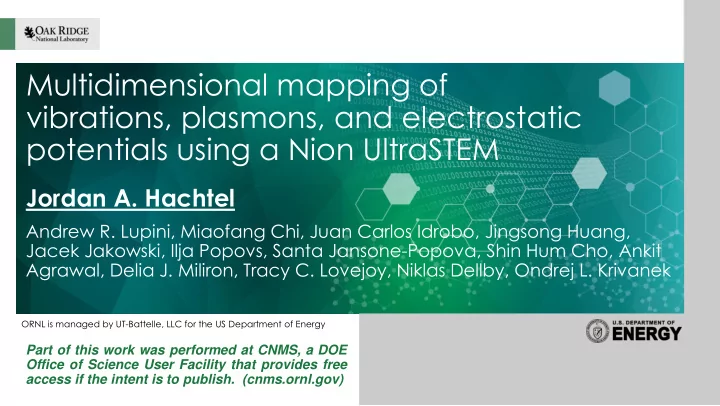

Multidimensional mapping of vibrations, plasmons, and electrostatic potentials using a Nion UltraSTEM Jordan A. Hachtel Andrew R. Lupini, Miaofang Chi, Juan Carlos Idrobo, Jingsong Huang, Jacek Jakowski, Ilja Popovs, Santa Jansone-Popova, Shin Hum Cho, Ankit Agrawal, Delia J. Miliron, Tracy C. Lovejoy, Niklas Dellby, Ondrej L. Krivanek ORNL is managed by UT-Battelle, LLC for the US Department of Energy Part of this work was performed at CNMS, a DOE Office of Science User Facility that provides free access if the intent is to publish. (cnms.ornl.gov)
1-Dimension Vibrational Spectroscopy of Organic Molecules L-Alanine: C 3 H 7 NO 2 H H C H H C O C H N H H O 2
Vibrational Spectroscopy in FWHM hBN the Electron Microscope 100 50 20 FTIR Spectrum Needs: • Enhanced resolution • Reduced background • Monochromated EELS 3
Energy Resolution Matters L-Alanine Vibrational EELS • Old Spectrometer – 15 meV Res. • New Spectrometer – 5 meV • Vibrational Fine Structure • Peaks @ 21 meV 4
Dark Reference and ZLP Movement Acquire 300 Acquier 300 dark 5
2-Dimensions Identifying Isotope-Labelled Amino Acids in Real Space L-Alanine: C 3 H 7 NO 2 12 C 13 C 12 C 13 C 12 C 13 C 6
Measuring Mass with Electrons • Isotopic-labeling influences vibrations • Isotopic changes – 160-180 meV Peaks – 200 meV Peak • Shift of ~200 meV peak for isotopic identification 7
Nature of 200 meV Peak 200 meV: C-O Stretch 8
Spatial Isotopic Resolution: Sample Preparation 12 C L-Alanine Sample 12 C L-Alanine Sample (After 13 C Loading) 9
Spatial Isotopic Resolution: Damage Free Linescan 10
Spatial Isotopic Resolution 11
3-Dimensions Mapping Plasmon Hybridization in Doped Semiconductors Flourine-doped Indium Oxide 12
Infrared Optical Response • Monochromated EELS detects IR Intensity (au) plasmons 100 nm • Geometric dependence observable 13
Non-negative Matrix Factorization Deconvolution • NMF for deconvolution Intensity (au) • Available in Hyperspy 100 nm 100 nm • Finds true localizations SI.decomposition(algorithm='nmf',output_dimension=2) • Multiple Peaks in 100 nm Side Mode 14
Effect of Component Number on Deconvolution • 2 Comp Fit: Not enough • Different Corner Modes • Different Side Modes • Plasmon Hybridization • 5 Comp fit: Too much 15
4-Dimensions Sub-Ångstrom Electric Field Mapping 16
Detectors for Four-Dimensional STEM Segmented Detectors Ronchigram Camera Pixelated Detectors Advantages Advantages Advantages ➢ Convenient and Versatile ➢ Fast Acquisition ➢ 4D Datasets ➢ Direct Signal Readout ➢ Surprisingly Powerful ➢ Phase Reconstruction Shibata et al., Nat. Comm . (2017 ) Tate et al., Microsc. Microanal. (2016 ) 17
4D-STEM Imaging on a Nion 2020 Camera 4D Dataset e - 2D Image HAADF Detector Ronchi Camera 9 x 9 Ronchigram ABF Detector 9 x 9 x 128 x 128 BF Detector 1 ms per Ronchigram Acquisition 18
4D-STEM in a Nion: What do you need? 1. Dipole in the Projector Lens Layer 2. Dipole in DQCM 3. Projector Lens 4D-STEM in a Nion: What do you do? 1. Switch to EELS Mode (Make a copy) 2. Adjust size of BF disk with Projector Lens(I go for 120 pixels) 3. Crop (and bin if you are in a hurry) 4. Align BF Disk to HAADF detector (DQCM dipole) 5. Align Beam to Camera (Projector Lens dipole) 6. Acqurie 4D-STEM Good News: Easy Bad News: Slow 19
Automatically Finding Ronchigram Center • 4D-STEM requires accurate knowledge of Ronchigram center • Center Finding Routine: – Sum, Blur, Cutoff • Sub-pixel accuracy 20
Image Reconstruction from a 4D Dataset Annular Dark Field Annular Bright Field Bright Field > 45 mrad < 30 mrad 15-30 mrad 21
Differential Phase Contrast on a Universal Detector Electric Field Surrounding Atom Ronchi Camera 22
Weighting Ronchigrams by the Center of Mass 23
Atomic Potential from the Electric Field 24
5-Dimensions Not yet, but inevitable 1. x-S can Direction 2. y- Scan Direction 3. u -Momentum Direction 4. v -Momentum Direction 5. Defocus 6. Time 7. Temperature 8. Electrical Bias 9. Dose 10. Accelerating Voltage 11.Orbital Angular Momentum String Theory in the Electron Microscope? 25
Dreams for the Future: • Interface between iPython Notebooks and Swift • Swift: Explore Newly Acquired Dataset • Notebook: Stored Analysis Pathway • Arbitrary Acquisition From a Reference Image • Linescans • Aloof Spectrum Imaging? • Live DPC • The triple-whammy bottleneck • Swift writes 4D-dataset to buffer • Buffer writes to library • Export from library to external hard drive • ORCA on SuperScan • Read DPC like other detector signals • Tune defocus condition • Alleviate hard drives, direct experiments 26
Measuring and Mapping Octahedral Tilts Polar Angle θ Azimuthal Angle φ Predicted: 25.7 o / 154.3 o Measured: 26.0 o / 152.5 o 27
Revealing Light Elements with STEM-DPC : 1.38 Å : 0.73 Å 28
Infrared Plasmonics • Noble Metals – Normally visible frequencies – Infrared with large dimensions • Doped Semiconductors – High free-carrier densities – Mid-Infrared wavelengths – Tunable by: • Geometry • Material • Doping Concentration 29
Tilted Spectrum Image Distal Face • Observe substrate induced effects • Measure and Proximal Face map infrared plasmons 100 nm Proximal Proximal Edge Distal Corner Distal Edge & Face & Face Corner 30
Phonons and Plasmons in the Same Dataset • Plasmons and phonons share infrared regime • Examine both in same SI • Future: Spatially-Resolved Plasmon-Phonon Interactions 31
Sub-Ångstrom Resolution in DPC Imaging : 0.72 Å ➢ Denoise and Interpolate for Subpixel Analysis ➢ Dy/Sc sites identifiable from Z- contrast ➢ Dy-pair resolvable in DPC 32
ICoM vs. DPC: Field Mapping DPC ICoM 1 nm 1 nm 1 nm 1 nm 33
Atom-by-Atom Imaging of the Electric Field HAADF Detector 34
Recommend
More recommend